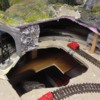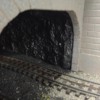a couple of "tricks of the trade" ( mind you I do "face off" stuff for a living)
when applying the latex thin the first coat, with 1 part ammonia five parts water to a heavy cream consistency, wet you brush with a fifty fifty water ammonia mix and keep it wet. Ammonia is the preservative for latex
do not use tap water with chlorine! the chlorine will jell the latex and it will go on globby.
Don't rush coats let each dry until the "white" goes away. after the second or third layer embed cheese cloth wet with the same ammonia / water mix you are using for your brush wring it damp dry and layer several coats of latex over it.
let the whole gizmo dry for a few days, you can accelerate the cure with moderate heat but don't go over 140 degrees best to stay near 120 for a top temp. I usually will put curing latex on top of one of those iol filled heaters. 9 that's me all high tech)
this will sound weird, but if you want a less flimsy mold you can add a little flat house paint to the latex, mix thoroughly . the resultant mix will be a little harder when cured. but be ware that what you don't use will gel in a few weeks or months with the wall paint added. it does make for a more stable and rapid built up of the mold however
your plaster master ( the casting you got from the mold form and aluminum foil) wil absorb some water right off hence the reason for thinning the first couple of coats plus this will eliminate air bubbles. you can rub a little spackle into any voids in you master before you start, ( they will show up in the latex)













